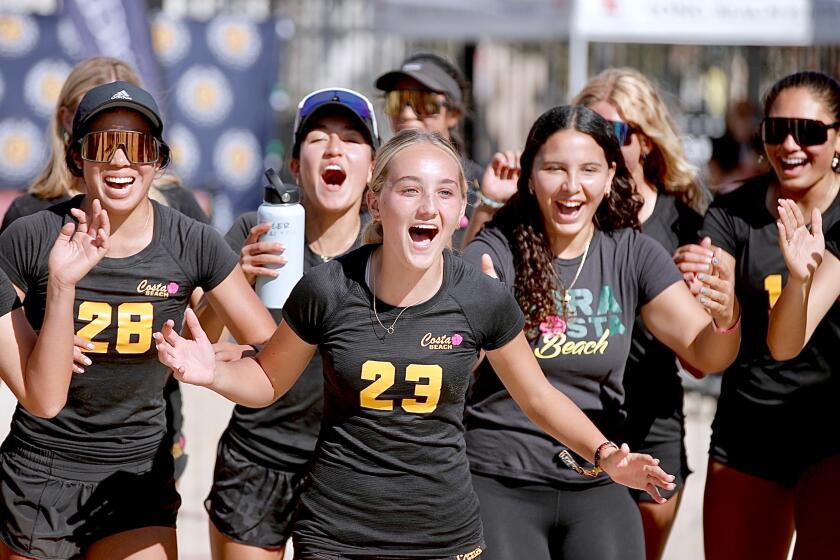Tennis / Julie Cart : Melissa Gurney Is a Member of New Brat Pack
- Share via
The Virginia Slims of Los Angeles could be one of the best tournaments this side of the U.S. Open. Entered in the $250,000 event, Aug. 11-17 at the Manhattan Country Club in Manhattan Beach, are Martina Navratilova, Chris Evert Lloyd, Hana Mandlikova, Pam Shriver, Claudia Kohde-Kilsch and Helena Sukova.
The tournament also features a group of younger tour players, the teen-age pretenders to the Navratilova-Lloyd dual-seated throne.
Leading the charge of the youth brigade is Gabriela Sabatini, the 16-year-old Argentine, now ranked No. 11. Another 16-year-old, Stephanie Rehe, is entered in the main draw. She is ranked No. 12 and has done well since turning pro in 1985.
And then there is Melissa Gurney of Palos Verdes, 17 and with one year as a pro, who received the last wild-card entry to the main draw. In October of 1984, in the Slims of Los Angeles, Gurney, then 15, took Lloyd to three sets before losing.
Gurney’s odyssey from amateur to pro has a familiar ring. In 1984, Gurney won the hard courts, grass courts and nationals in the girls’ 18s. There was, as she says, “Nothing left to do in juniors.” She turned pro the next year, one day before her 16th birthday.
“Looking back, I’m not at all unhappy with my decision (to turn pro),” Gurney said. “I feel pretty good about it now. I’m still in school, so my tournament schedule is limited. The only thing that has changed was, before, I intended to postpone the tour and play in college, now I am not going to do that. I do want to go to school at some time, but for now it’s going to be the tour full time.”
Gurney has finished her junior year at the Chadwick School, where she is an honors student. Her father, Ram, teaches history at the school.
“It’s very important to my father that I graduate,” she said.
Accordingly, Gurney’s tournament schedule is arranged around her classes. She has played in only 11 tournaments this year, but she uses the summer school break to catch up.
“I feel really good right now,” she said. “With school out, I can do more. I have more time for practice. At the moment, I’m just working on general things. You can’t try to change your whole style right before a major tournament.”
Gurney is a baseliner who is trying, like others with her style, to play more of a serve and volley game.
Gurney’s baptism into the pros took an added dimension with the publication of a book by Karen Stabiner entitled “Courting Fame,” an in-depth look at the junior tennis scene. Gurney was one of the players featured in the book, which takes a tough look at the pressure placed on young female players.
“I think it (the book) was a little on the negative side,” Gurney said, choosing her words carefully. “I think it might scare some kids off, which would be too bad. There really is so much that’s fun--the traveling and the camaraderie. I’m really very happy with this life.”
Tennis Notes
John McEnroe, in the August issue of World Tennis magazine: “I was brought up not to smile on the court because it would take away from the concentration. There are times when I hit a shot, and inside I’m like ‘God, that feels good, that feels great.’ And I don’t show it the way normal people show it, (but) I’m a very happy man.” . . . Last week’s match was the fifth consecutive on the road for the U.S. Davis Cup team. In Mexico City, they came away with a 4-1 win but made few friends. Tim Mayotte defeated Leonard Lavalle in a long and dramatic five-set match to clinch the U.S. win, but not before Mayotte got into several verbal battles with some of the 8,000 partisan fans. The crowd was so disruptive that Lavalle was penalized a point and the umpire threatened to disqualify the entire Mexican team. It didn’t stop there. After the match Lavalle’s father, Luis, tearfully attacked Mexican sportswriters for supporting the ‘foreigners’ over the home team. Then he and the vice president of the Mexican tennis federation got into a fistfight with Mexican reporters. Finally, the Mexican tennis federation was fined $13,000 by Davis Cup organizers for “sponsor violations.” Local promoters gave top advertising billing to local sponsors, most of whom are in direct competition with the international Davis Cup sponsors. Nothing new. Davis Cup, with its rampant nationalism, rarely has a dull moment.
More to Read
Go beyond the scoreboard
Get the latest on L.A.'s teams in the daily Sports Report newsletter.
You may occasionally receive promotional content from the Los Angeles Times.











